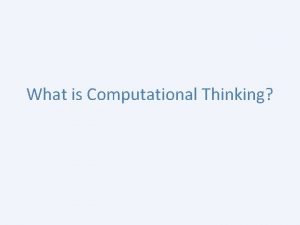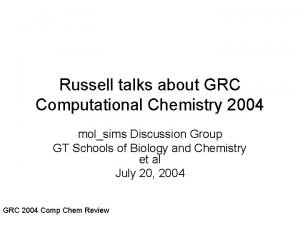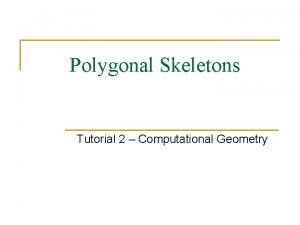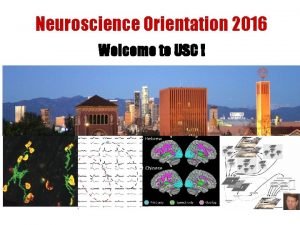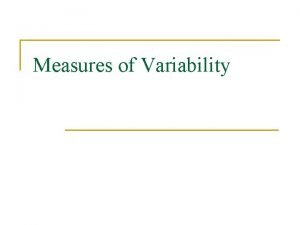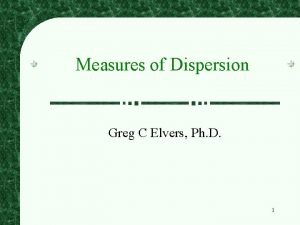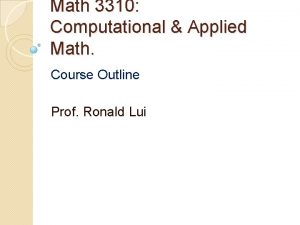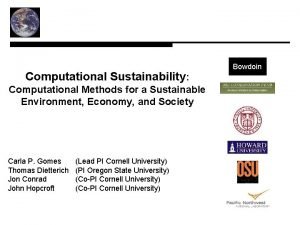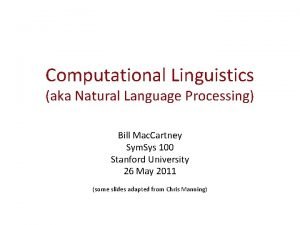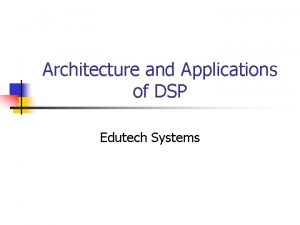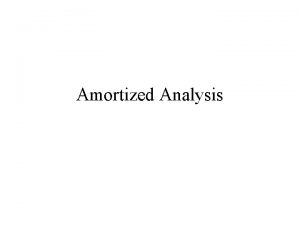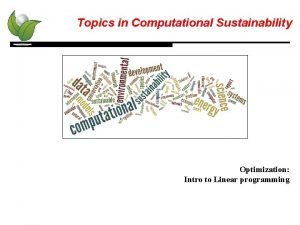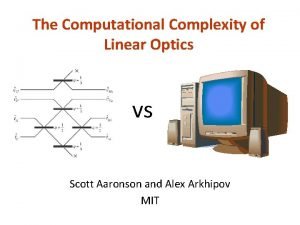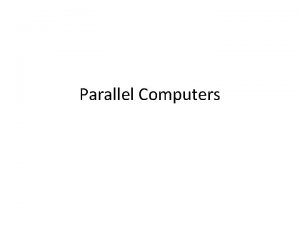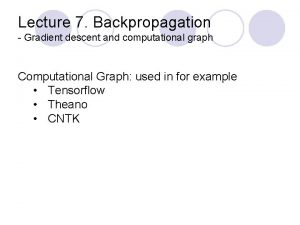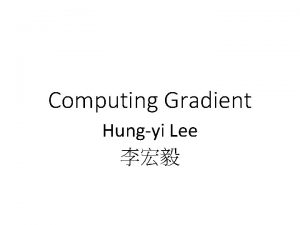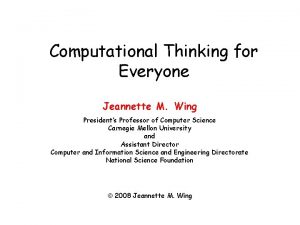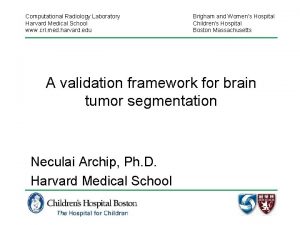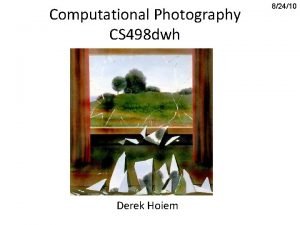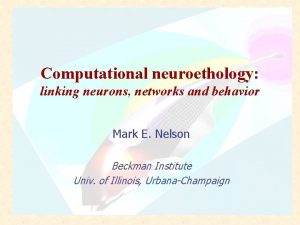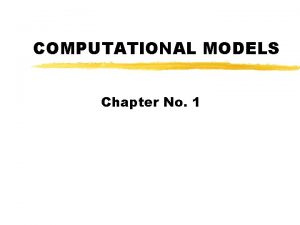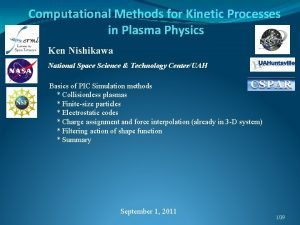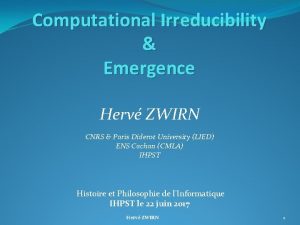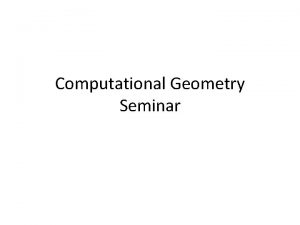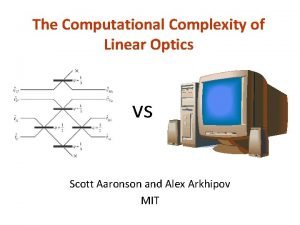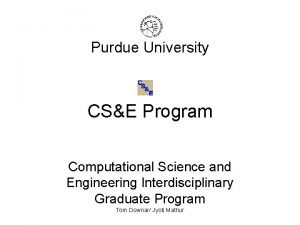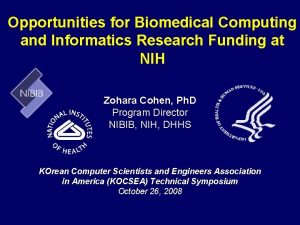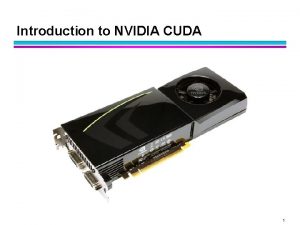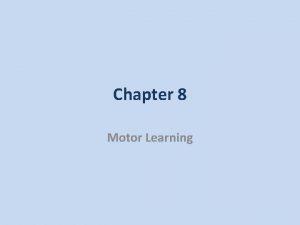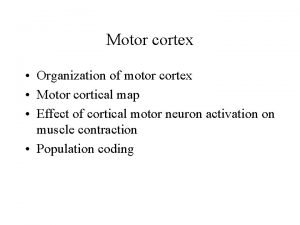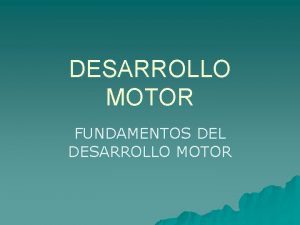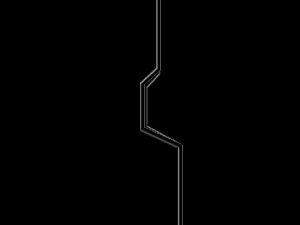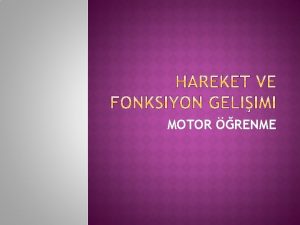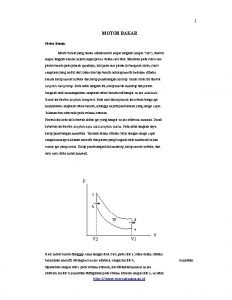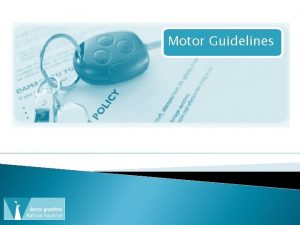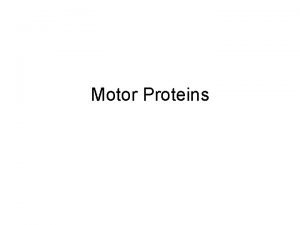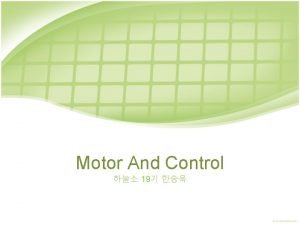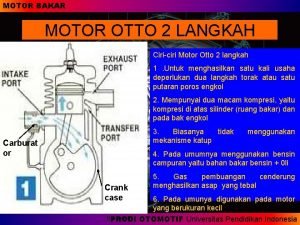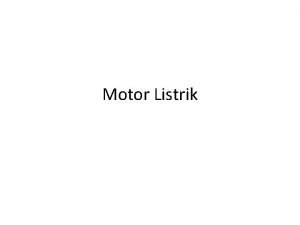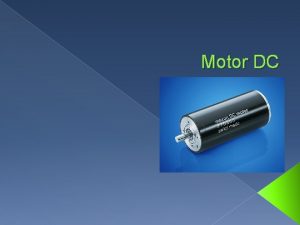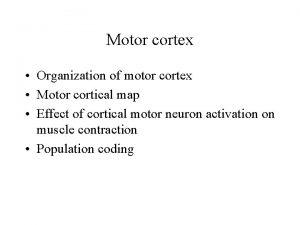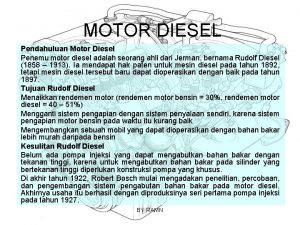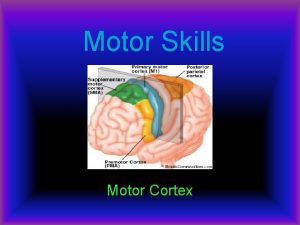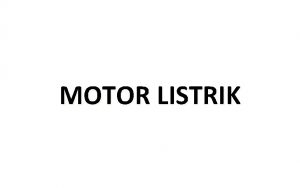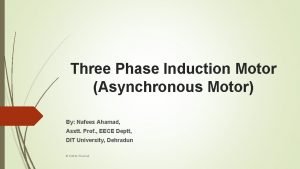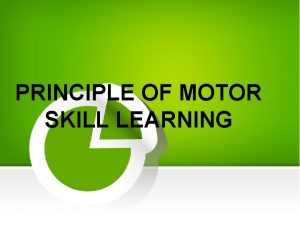Computational Analysis of Motor Learning Motor Learning Three






































- Slides: 38

Computational Analysis of Motor Learning

Motor Learning Three paradigms field adaptation Visuomotor transformations Sequence learning Does one term (motor learning) fit all? How to determine similarities/differences? Acquisition: On-line vs. KR feedback Generalization: Transfer Force

Motor Learning Three paradigms field adaptation Visuomotor transformations Sequence learning Force Does one term (motor learning) fit all? Neural systems: Do these tasks engage common regions?

Motor Learning Three paradigms field adaptation Visuomotor transformations Sequence learning Force Does one term (motor learning) fit all? Neural systems: Do these tasks engage common regions? Test case: Cerebellum

Force field adaptation is impaired in patients with cerebellar degeneration and not basal ganglia degeneration. Smith and Shadmehr, 2005

Prism adaptation impairment in patient with bilateral cerebellar stroke. Control Participant Cerebellar Stroke Martin et al. , 1996

Sequence learning is absent (ipsilesional) in patients with unilateral cerebellar stroke. S S S R Gomez-Beldarrain et al. , 1998

Classical conditioning of eyeblink response

Cerebellar lesions selectively abolish the learned response. Mc. Cormick et al. , 1984; many others

Model system of motor learning 1. Dissociation of performance and learning. 2. Many species. 3. Specification of US and CS pathways. 1. -- US, CS simulations. -- Reversible lesions 4. Genetic manipulations.

Cerebellar lesions selectively abolish the learned response. But not all forms of classical conditioning. Pre-training lesions Mc. Cormick et al. , 1984; many others

Specifying domain of function. Task domain: Cerebellum for motor learning. Computation: Cerebellum for learning precise timing between stimulus events.

Specifying domain of function. Task domain: Cerebellum for motor learning. Computation: Cerebellum for learning precise timing between stimulus events. Timing hypothesis accounts for dissociation of heart rate and eyeblink responses.

Lesions of the cerebellar hemisphere do not abolish eyeblin response but do disrupt the adaptive timing. Prelesion Postlesion Trained with 200 ms ISI Trained with 500 ms ISI Perrett et al. , 1993

Multiple levels of learning. Simple associations at DCN Precise timing from cerebellar cortex to flexibly make response adaptive.

Motor Learning Three paradigms field adaptation Visuomotor transformations Sequence learning Force Neural systems: Do these tasks engage common regions? Revisit role of cerebellum: Do these tasks require precise timing?

Sequence learning as test case. Stimuli appear at one of four positions. Press response key in corresponding position. Stimuli follow sequence or are chosen at random.

Sequence learning as test case. Stimuli appear at one of four positions. Press response key in corresponding position. Stimuli follow sequence or are chosen at random. Learning series of spatial associations. Stimuli, responses lack precise timing. Transfer indicates effector-independent learning. Computational analysis: Cerebellum not essential for sequence learning.

Avalanche of patient and imaging studies with SRT task central question: Is Structure X involved in learning? Extensive focus on basal ganglia and cerebellum given hypothesized role in skill, procedural learning, and automaticity.

Patient Groups Basal ganglia Parkinson’s: Focal BG lesions Cerebellum Degree of Learning Compared to Controls Normal Attenuated None 2 2 0 4 1 1 1 0 5

Patient Groups Basal ganglia Parkinson’s: Focal BG lesions Cerebellum Imaging results Degree of Learning Compared to Controls Normal Attenuated None 2 2 0 4 1 1 1 0 5 Directional Change in Activation with Learning Increases No Change Decreases Basal Ganglia 5 6 0 Cerebellum 0 6 4

Patient Groups Basal ganglia Parkinson’s: Focal BG lesions Cerebellum Degree of Learning Compared to Controls Normal Attenuated None 2 2 0 4 1 1 1 0 5 Imaging results Directional Change in Activation with Learning Increases No Change Decreases Basal Ganglia 5 6 0 Cerebellum 0 6 4 If both BG and Cerebellar lesions impair SRT learning, why are imaging results so different? If cerebellar lesions are so devastating to learning, why decrease with learning, esp. when motor cortical areas show increase w/ learning?

Sequence learning as test case. Performance-based hypothesis: Cortical-cerebellar interactions to maintain S-R mapping. Non-cerebellar systems forming sequential associations. Patient deficit: Poor sequence learning because noisy S-R codes provide weak input for associative mechanisms.

Prediction: Deficit in SRT learning will be reduced in patients with cerebellar lesions if S-R coding requirements are minimized.

Prediction: Deficit in SRT learning will be reduced in patients with cerebellar lesions if S-R coding requirements are minimized. Reach to target location Reach to target associated with central color Successive targets follow 8 -element sequence or selected randomly. Symbolic cues tax SR coding system (e. g. , Wise premotor)

Patients selectively impaired with symbolic cues. Consistent with performance problem rather than sequence learning per se.

Experiment 2: Use more traditional keypressing SRT task Compare with patient control: PD patients

Experiment 2: Use more traditional keypressing SRT task Compare with patient control: PD patients Ataxia group shows selective impairment with symbolic cues. Controls and PD learn with both cues.

Results bring together patient and imaging work. Lesion All human cerebellar studies have used symbolic cues. One monkey lesion study used direct cues: normal performance

Results bring together patient and imaging work. Lesion All human cerebellar studies have used symbolic cues. One monkey lesion study used direct cues: normal performance Imaging Consistent with imaging studies showing reduction in cerebellar activation over the course of learning. Demands on maintaining S-R mapping will decrease over time as mapping becomes well-learned. Directional Change in Activation with Learning Increases No Change Decreases SRT learning 0 6 4

Results bring together patient and imaging work. Lesion All human cerebellar studies have used symbolic cues. One monkey lesion study used direct cues: normal performance Imaging Consistent with imaging studies showing reduction in cerebellar activation over the course of learning. Demands on maintaining S-R mapping will decrease over time as mapping becomes well-learned. Directional Change in Activation with Learning Increases No Change Decreases SRT learning 0 6 4 Prediction: Weak cerebellar/prefrontal activation with direct cues.

Motor Learning Cerebellar role in learning Sequence learning Indirect (no timing) Force field adaptation likely (on-line timed error signal) Visuomotor transformations ? ? ?

Motor Learning Cerebellar role in learning Sequence learning Indirect (no timing) Force field adaptation likely (on-line timed error signal) Visuomotor transformations ? ? ? Imaging and patient work suggests yes. Working memory account: Two S-R maps required in transformed environment S-R Map 1: Old Map S-R Map 2: Hypothesis of New Map

Motor Learning Cerebellar role in learning Sequence learning Indirect (no timing) Force field adaptation likely (on-line timed error signal) Visuomotor transformations ? ? ? Compare single- and multi-step transformations. Single: 25 deg displacement in one step Multi: 5 deg every 20 trials Predictions?

Classic model of cerebellum and error detection and correction. Parallel fibers: Simple spikes indicate context. Climbing fibers: Complex spikes indicate error. Complex spike activity leads to weight change.

“Constant” somatosensory input that is either expected or unexpected Unexp. Exp. Unexp

Unexp. Exp. Unexp Exp Unexp

Errors of Omission and Commission Actual Yes Expected Yes No Correct Commission Errors of commission are well-timed. Errors of omission lack precise timing. No Omission Correct
 Characteristics of computational thinking
Characteristics of computational thinking Computational thinking algorithms and programming
Computational thinking algorithms and programming Grc computational chemistry
Grc computational chemistry Using mathematics and computational thinking
Using mathematics and computational thinking Straight skeleton
Straight skeleton Neuroscience major usc
Neuroscience major usc Standard deviation computational formula
Standard deviation computational formula Semi interquartile range
Semi interquartile range Computational math
Computational math Algorithmic thinking gcse
Algorithmic thinking gcse Computational sustainability cornell
Computational sustainability cornell Chomsky computational linguistics
Chomsky computational linguistics Xkcd computational linguistics
Xkcd computational linguistics Cmu comp bio
Cmu comp bio Dsp computational building blocks
Dsp computational building blocks Time complexity
Time complexity Computational sustainability subjects
Computational sustainability subjects The computational complexity of linear optics
The computational complexity of linear optics Leerlijn computational thinking
Leerlijn computational thinking The computational speed of computers
The computational speed of computers Computational graph backpropagation
Computational graph backpropagation Computational graph
Computational graph Computational thinking jeannette m wing
Computational thinking jeannette m wing Crl radiology
Crl radiology Computational photography uiuc
Computational photography uiuc Computational neuroethology
Computational neuroethology Computational model in computer architecture
Computational model in computer architecture Computational methods in plasma physics
Computational methods in plasma physics Computational irreducibility
Computational irreducibility Computational geometry
Computational geometry Computational chemistry branches
Computational chemistry branches Kinship domain in artificial intelligence
Kinship domain in artificial intelligence Computational chemistry aws
Computational chemistry aws Computational security
Computational security The computational complexity of linear optics
The computational complexity of linear optics Tu bergakademie freiberg computational materials science
Tu bergakademie freiberg computational materials science Purdue computational science and engineering
Purdue computational science and engineering Nibib.nih.gov computational
Nibib.nih.gov computational Computational engineering and physical modeling
Computational engineering and physical modeling
